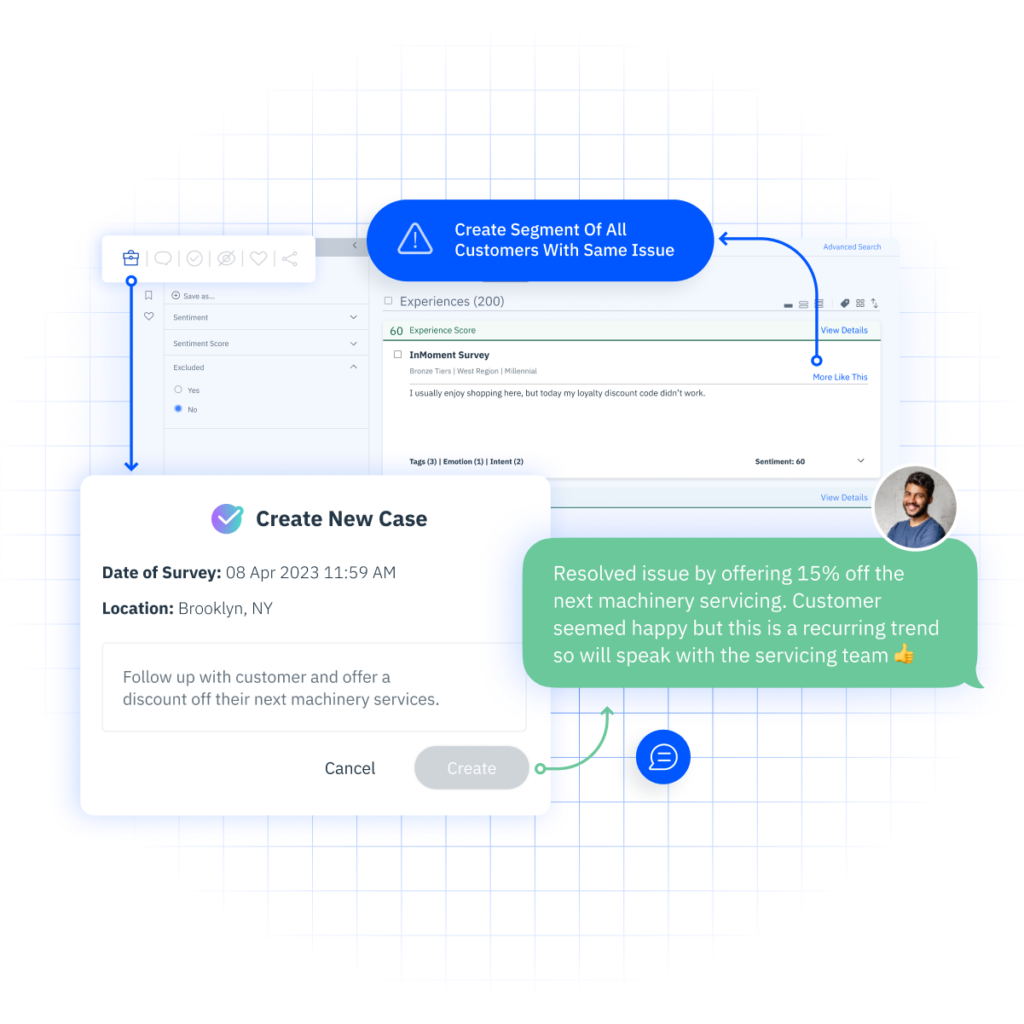A Deep Dive into the Voice of the Customer
Embracing the Voice of the Customer (VoC) is a powerful strategy for businesses looking to thrive in a customer-centric environment. By actively listening and responding to customer feedback, you can build stronger relationships, enhance your products and services, and position your business for sustained success.
Did you know that over 70% of consumers expect personalized communications and tailored products/services from companies they buy from? Of those customers, 76% get frustrated when they do not receive any level of personalization. When companies do offer personalized experiences, 78% of those customers who receive that level of personalization are likely to make repeat purchases.
With these statistics in mind, it is clear that delivering consistent, memorable experiences is a must for any organization looking to build and sustain a loyal customer base. The only way to do this is by listening to what your customers are saying, which is referred to as the Voice of the Customer.
What is Voice of the Customer?
Voice of the Customer (VoC) is the process of gathering information regarding what customers think and feel about their experiences with a business. The goal is to learn about their expectations regarding the business’ products or services.
Often applied as a market research technique by firms looking to achieve a better and more complete understanding of the customer, Voice of the Customer can also help companies measure and understand the experiences that they deliver to customers. Armed with this knowledge, companies can build stronger brands, function as more efficient organizations, and deliver a better customer experience.
A Voice of the Customer program helps your business reap the benefits of listening, acting, and responding to what customers say about your brand, product, service, or business location. This can help you deliver improved experiences, offer better products and services, and create more value for customers.
Why Voice of the Customer Is Important
Voice of the Customer data is important for several reasons in business and product development. Primarily, Voice of the Customer programs help organizations become more customer-centric by understanding customer needs, preferences, and expectations. This customer-centric focus is crucial for developing products, services, and experiences that align with what customers truly want.
VoC data is also a valuable source of insights for innovation. Understanding customer pain points and desires can guide the development of new products or features that address unmet needs, giving companies a competitive advantage.
Essentially, once fortified with this extensive and comprehensive data, CX leaders can:
- Discover why feedback scores, such as net promoter scores are not up to par.
- Comprehend customer desires, needs, and criticisms.
- List the above data in order of importance for improving performance.
- Fully grasp customers’ perception of the value of a company’s product(s) and/or service(s) offer.
- Learn if and where the company is fulfilling its promises and areas where it fails to do so.
- Utilize all the data to inform improvements in the way products and services are created and offered to a now better-understood customer demographic.
- Solicit customer feedback to evaluate new ways of gaining a competitive advantage.
- Generate advanced marketing insights and opportunities.
Benefits of a Voice of the Customer Program
Businesses without a Voice of Customer program observe which of their products or services are being sold most frequently, and assume that is what customers want more of. However, this approach leaves out key qualitative details such as which areas of the buying experience customers would change.
Voice of the Customer programs allows organizations to gain a deeper understanding of their customers and the decisions they make. These benefits can range from operational improvements to changes in product development. Here are some common benefits of effective voice of the customer programs:
Improve Customer Retention
It is no secret that your existing customers are easier to sell to and will spend more than first-time customers. By implementing a Voice of the Customer program, you can open a direct line of communication for customers to address their concerns and frustrations so that the company can act on those frustrations to improve the overall experience. This will allow you to decrease customer churn and improve customer retention.
Improve Brand Reputation
A Voice of the Customer program enhances brand reputation by ensuring timely and thoughtful responses to customer feedback. By staying connected to the platforms where customers share their experiences, your business can quickly address online reviews, demonstrate attentiveness, and show a commitment to customer satisfaction. This responsiveness not only resolves individual concerns but also builds trust and reinforces a positive brand image across your customer base.
Reduce Customer Complaints and Faster Resolutions
By systematically gathering customer opinions and experiences, businesses can identify issues early on, even before customers actively complain. Early detection allows for proactive problem-solving.
Moreover, Voice of the Customer programs help businesses understand the severity and impact of different issues. This allows for the prioritization of problems based on their urgency and potential impact on customer satisfaction. Addressing high-priority issues first contributes to faster resolution.
Drive Product Innovations
Voice of the Customer data helps companies stay aligned with market trends and shifts. This knowledge is crucial for driving product and service innovation, adapting strategies, staying relevant, and ensuring that your offerings remain in tune with evolving customer expectations.
Boost Your Revenue
A natural consequence of expanding the customer base and retaining customers is an increase in revenue. As companies monitor customer feedback and trends, they have a clear picture of what products and services customers want and are willing to pay for, which means that the company can provide those with greater accuracy.
If you want to see how much revenue InMoment can deliver for you with Voice of Customer surveys, check out our ROI calculator!
Improve Customer Experience
All of these benefits work together to create a more cohesive and satisfying customer experience. By actively listening to customer feedback, addressing their needs, and continuously improving products and services, businesses can deliver a personalized and seamless experience at every touchpoint. This holistic approach not only meets but often exceeds customer expectations, fostering loyalty, encouraging positive word-of-mouth, and ultimately driving long-term success.
3 Questions to Consider Before Building a Voice of the Customer Program
These three questions can guide companies’ efforts to implement an effective Voice of the Customer program to improve the customer experience, retain customers, and boost revenue.
1. What Is the Goal of the Voice of the Customer Program?
Without a clear goal, it is difficult to start a Voice of the Customer program since the strategies used should reflect the business objective. Before companies start building a program, they should first examine potential objectives and determine which will be the most beneficial for their specific needs.
The objectives of a voice of the customer program can be divided into two main categories: benchmarking and continuous improvement.
Benchmarking
Programs that focus on benchmarking as an objective tend to be more comparative. This means that the surveys used to gather customer feedback will use the same set of questions for every respondent, typically in a rating format, and then compare those ratings to each other to find areas for improvement. Often, the focus is on the scores themselves instead of the reason for those ratings, so companies that use this objective will get more general feedback and causality.
Continuous Improvement
Continuous improvement objectives, on the other hand, can be more personalized based on certain aspects of the customer and their interaction with the company. While the accompanying surveys can include rating questions, there will also be some open-ended questions that allow respondents to clarify their reasons for the scores they gave. This method can give more detailed insight into the causes of dissatisfaction.
Companies should choose one of these objectives based on the information that they wish to gather to work towards certain goals. Some of the possible goals are:
- Customer research: For this, companies gather the information that helps them better understand the needs and wants of their target customers.
- Customer retention: Learning how to best keep existing customers satisfied with the products and services offered is crucial for customer retention.
- Acquiring new customers: Just as important as retaining customers is acquiring new ones. With this goal in mind, companies should learn how to increase interest in their brand to attract new customers.
- Improving brand image: This goal focuses on finding out how customers view a company’s brand and what can be done to improve that image.
- Cost reduction: Focusing on cost-effectiveness by recognizing where you can reduce spending will help you increase profitability and prove ROI.
- Increasing customer lifetime value: Customer lifetime value is the revenue earned from a single customer over time. Increasing that will cause your customers to promote your brand for you.
2. What Metrics Should Be Measured Throughout the VoC Program?
Once a company has chosen a goal to drive its VoC program, it should define which metrics will be measured to demonstrate progress and focus the efforts for more improvements. Some common metrics in a Voice of the Customer program include customer experience KPIs such as Net Promoter Score, Customer Effort Score, and Customer Satisfaction Score.
When selecting metrics, consider the holistic picture they paint and how they align with your business goals. Combining quantitative metrics with qualitative insights from customer feedback ensures a comprehensive understanding of the Voice of the Customer. Regularly review and adjust your chosen metrics to stay responsive to changing customer needs and business objectives.
3. How Should the Success of the VoC Program Be Measured?
A Voice of the Customer program is only effective if it drives action. To determine whether the feedback being gathered is useful, it is important to look at what has changed since the program was implemented. Measuring success is dependent on setting a clear goal and choosing specific metrics that align with that goal. Because of this, companies should consider whether the metrics being measured are improving over time. The changes made to improve the metrics should help the company work towards its main objective.
Building a Voice of the Customer Program: Best Practices
Before you jump in and begin building your Voice of the Customer program, you’ll need to earnestly attempt to see through your customers’ eyes and link their experience to your business outcomes. Here are some areas of focus and best practices to follow:
Identify Customer Touchpoints
Customers form their impression of a product or service through multiple interactions with an organization. For instance, folks may find a business by doing an online search or via an ad. They might be introduced through blogs or site reviews, then shop on the company’s website, stop by at a brick-and-mortar retail location, and later on, get in touch with the customer service department.
A Voice of the Customer program often starts with customer journey mapping and identifying the various touchpoints that will add up to the full customer experience with the company. Keep in mind that combining insights from multiple touchpoints provides a comprehensive view of customer experiences and helps drive informed decision-making.
Collect and Connect Feedback Across Data Channels
Successful Voice of the Customer programs are founded on a company’s ability to listen to customers. To do that successfully, your Voice of the Customer program needs to work as part of your omnichannel customer experience so that you can monitor what customers are saying across all different platforms.
Analyze Customer Data
After gathering a sufficient amount of data, it’s time to make sense of it. Whether you’re working alone or as a part of a team, you will need to come up with a standard way to understand the Voice of the Customer.
Analytical methods like natural language processing (NLP) and sentiment analysis can help your business pin down customer sentiment data, emotions, and feelings, helping you see more clearly than ever what customers like and dislike about your brand.
By translating information into vision, you can achieve a better understanding of the needs, wants, feelings, sentiments, and expectations of your customers. The insights you gather from the Voice of the Customer data will help your entire organization more accurately measure — and more efficiently improve — customer experience.
Collaborate with Teams Across the Entire Organization
Collaboration with other teams within your organization is crucial when managing Voice of the Customer data. This enhances the effectiveness of your efforts and ensures a more comprehensive and integrated approach to customer-centric strategies.
Cross-functional insights are also made possible with greater collaboration. This is why it is important to understand what CX teams in an organization work for your business. When you understand what time is heading the Voice of the Customer program, they can facilitate collaboration across the business. By working with other teams, you gain insights into the end-to-end customer journey, enabling a more comprehensive analysis of customer interactions and pain points.
Take Action and Deliver Insights to the Right People
With all the data and analysis done, you’re ready to create a custom, on-brand Voice of the Customer plan that spurs your team to action in ways that meet the needs of your customers. But it’s not enough to just create a plan and execute it. You’ll also need to monitor its effects regularly. Integrated customer experience platforms allow you to create custom reports that inform company leadership of the effects of Voice of the Customer data on a daily, weekly, or even monthly basis.
Don’t forget to share your Voice of Customer insights with key stakeholders and decision-makers. This will unite your company around the goal of meeting customer needs, and to guide and empower everyone to foster improvements in customer experience.
Monitor and Act on Customer Experience Trends
Ongoing monitoring assists in tracking a company’s progress as time goes on. Companies can get stuck debating what metrics they should target. What is more important is to stick to a metric, build a system that lets feedback flow in effortlessly, and watch the metric improve over time, as employees act on this valuable feedback.
How to Collect VoC Data
There are multiple ways to gather or capture Voice of the Customer data. Each of these has benefits and drawbacks, which is why a company may choose to use a combination of these sources and techniques instead of a singular method of collecting data.
As you collect Voice of Customer data, it’s good practice to select the right touchpoints and consider the variety of channels that customers use to interact with your brand throughout their journey. With customer data fragmented across different systems and departments, it may be challenging to identify or prioritize opportunities for improvement without a holistic or integrated approach to managing Voice of the Customer and the customer experience.
Customer Interviews
The traditional technique of gathering data through a customer interview has stuck around for so long because it is a direct way of gathering feedback. Interviews can be done in person, over the phone, or through email depending on the preferences and needs of a company. This technique allows companies to better understand the point of view that a customer or group of customers shares in their interaction with the company.
Surveys
Different types of surveys can be useful when collecting customer feedback. Online, email and SMS customer surveys can include different types of questions to help your team gather meaningful insights into issues that customers face. Some of the different survey questions include multiple-choice questions, drop-down questions, and open-ended questions. The key is to ask the right questions at the right time to gain a better understanding of customers and their expectations at any given point in the customer journey.
Live Chat
A live chat feature on the website is becoming increasingly popular due to the ability to collect real-time customer feedback. Live chats can gather more than customer complaints; they can also provide companies with the opportunity to schedule a follow-up survey to learn about the customer experience on the site. Another great feature is the ability for companies to respond quickly to an issue, which reduces the risk of customers leaving the site feeling unsatisfied with the services or products.
Online Reviews and Social Media
Another way for companies to interact with customers and gather VoC data in real time is through online reviews and social media. Companies can engage in two-way communication with their client base to learn more about what customers are looking for, predict future trends, and gather feedback directly from the source.
A large part of retaining customers is a positive brand reputation, and responding to online reviews can demonstrate that a company is aware of how customers view their products or services. A good review management strategy also allows companies to learn more about the frustrations that customers face so that they can implement measures to resolve these frustrations and issues.

Website Behavior
Along with these other techniques for collecting data, a company can analyze the behavior of customers on their website by using tools like heat maps. The company can track these behavior patterns and test potential changes to see what works and what doesn’t, all to create a smoother user experience.
Focus Groups
Focus group discussions are a common and effective method for collecting Voice of the Customer data. Focus groups involve a small, diverse group of participants who discuss their opinions, perceptions, and experiences related to a particular product, service, or topic.
By leveraging focus groups for Voice of Customer data collection, businesses can gain valuable qualitative insights that go beyond quantitative metrics, helping them better understand the nuances of customer perceptions and preferences.
Voice of Customer: Examples of Survey Questions
The questions that a company asks as part of its Voice of the Customer program will depend on the goal set at the beginning. For example, if the goal is general customer research, the company will want to ask questions that tell about the demographics of their audience, including:
- Which of the following categories best describes your age?
- Which of the following genders do you most identify with?
- What is the highest level of education you have achieved?
- How many people work at your company or organization?
On the other hand, the company should ask questions about its products and how they compare to competitors if the goal is to increase customer retention. For example:
- How does [company, brand, product, or service] compare to the competition?
- What do you like best about [company, brand, product, or service]?
- What do you want to be improved about [company, brand, product, or service]?
If the goal is to acquire new customers, companies can ask about how the audience makes decisions. A potential question is:
- What factor(s) matter most to you when selecting a company for [product or service]?
Finally, companies should ask about their brand if the goal is to improve their brand image. These questions could ask things like:
- What word or phrase comes to mind when you see or hear [company, brand, product, or service]?
- What company comes to mind first when you think of [company, brand, product, or service]?
- Where have you seen or heard information about [company or brand] in the past six months?
How InMoment Can Power Your VoC Program
Firms are no longer limited to managing Voice of the Customer data from a random sample of customers; now, they can listen in to every customer and every conversation at various stages of the customer journey — not to mention, dig deeper into data on both macro and micro levels.
InMoment’s combination of award-winning technology and expert services can power your Voice of the Customer program and make it comprehensive, simple, and scalable. Experience the transformative capabilities firsthand by exploring our demo. With InMoment, you can navigate and interpret valuable Voice of the Customer data to understand where to focus and how to create the maximum impact for your customer and your business.
References
Mckinsey & Company. The value of getting personalization right—or wrong—is multiplying. (https://www.mckinsey.com/capabilities/growth-marketing-and-sales/our-insights/the-value-of-getting-personalization-right-or-wrong-is-multiplying). Accessed 8/27/24.






